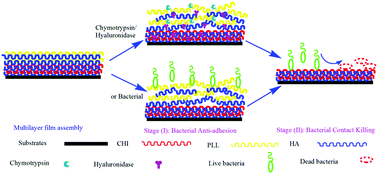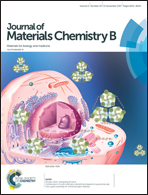Bacterial infection microenvironment-responsive enzymatically degradable multilayer films for multifunctional antibacterial properties
Abstract
The adhesion of bacteria is one of the most important stages in biofilm formation and bacterial infection. Once bacteria have adhered to a biomaterial surface, it is hard to eliminate them, and bacterial growth and infection are inevitable. In the current study, we have designed and constructed enzymatically degradable (hyaluronic acid/chitosan)n–(hyaluronic acid/polylysine)n ((HA/CHI)n–(HA/PLL)n) composite multilayer films via a layer-by-layer self-assembly method. Spectroscopic ellipsometry and scanning electron microscopy cross section measurements showed the exponential growth behavior of (HA/CHI)10–(HA/PLL)10 multilayer films (∼2 μm). The increased secretion of hyaluronidase and chymotrypsin in the bacterial infection microenvironment led to the fast degradation of the outer (PLL/HA)n multilayer films in the first 24 h. Enzymatic degradation of the multilayer films efficiently reduced the adhesion of both Staphylococcus aureus and Escherichia coli (>99%). Bacterial live/dead staining demonstrated the bactericidal action of the remaining bottom (CHI/HA)n multilayer films against the two kinds of bacteria. In vivo subcutaneous tests on New Zealand white rabbits, wound appearance and histopathology analysis showed that the implantation of composite multilayer film-modified PDMS promoted wound healing and the materials demonstrated a self-defense antibacterial effect. The material demonstrated both anti-adhesive and bactericidal properties and could be used to modify biomedical implants.



 Please wait while we load your content...
Please wait while we load your content...